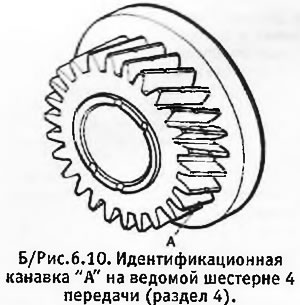2. Inspect the gearbox and differential case for cracks or damage, especially around the bearing or bushing. The gearbox housing, differential case and output shaft center bearing cap are re-ground after installation and therefore none of these parts can be replaced individually.
3. You can decide in advance which parts of the box require special attention (even during the operation of the machine, before removing the box) and clarify this information during the inspection of parts.
4. Inspect the teeth of all gears for uneven or excessive wear, as well as for chips. If a damaged gear is found, carefully inspect the gear with which the first one is engaged (it usually needs to be replaced). All gears must rotate smoothly on their bushings or bearings and not wobble on them. Do not mistake for a defect the groove cut in the teeth of the driven gears of 1st, 3rd and 4th gears in the case of SR models (see b/fig. 6.10). This groove is an identification mark so that these gears can be distinguished from similar gears on the GL and GR models, which have a different number of teeth and different gear ratios.

5. One of the reasons for the noisy operation of the box is the wear of the bearings. Rinse and dry the bearings thoroughly and inspect them for scratches, gouges and blue spots. By rotating the bearing rings, check them for smooth running and no noise during operation. Wear of the bearings is accompanied by the appearance of play, if it is excessive, the bearing must be replaced. After inspecting the bearings, lubricate them with clean engine oil to prevent corrosion, and wrap them well in paper so that dirt and dust do not get into them. The 2 half shell bearings of the input shaft must be replaced regardless of their condition.
6. Carefully inspect synchronizers for excessive wear and damage. If during the operation of the box you notice that the synchronizers do not work well, you need to replace them as an assembly.
7. Inspect the forks for wear in the places where they rest against the synchronizers. Wear here should be minimal. If in doubt, the plugs must be replaced.
8. Inspect the rods and retainers for wear, which can lead to inaccurate gear engagement, and replace them if necessary.
9. Inspect all other details (speedometer drive gears, blocking plungers, ball springs, etc.) for wear and damage and replace if necessary.
10. Based on the results of the inspection, decide which parts are to be replaced and evaluate whether it would be more economical to purchase a replacement box.
